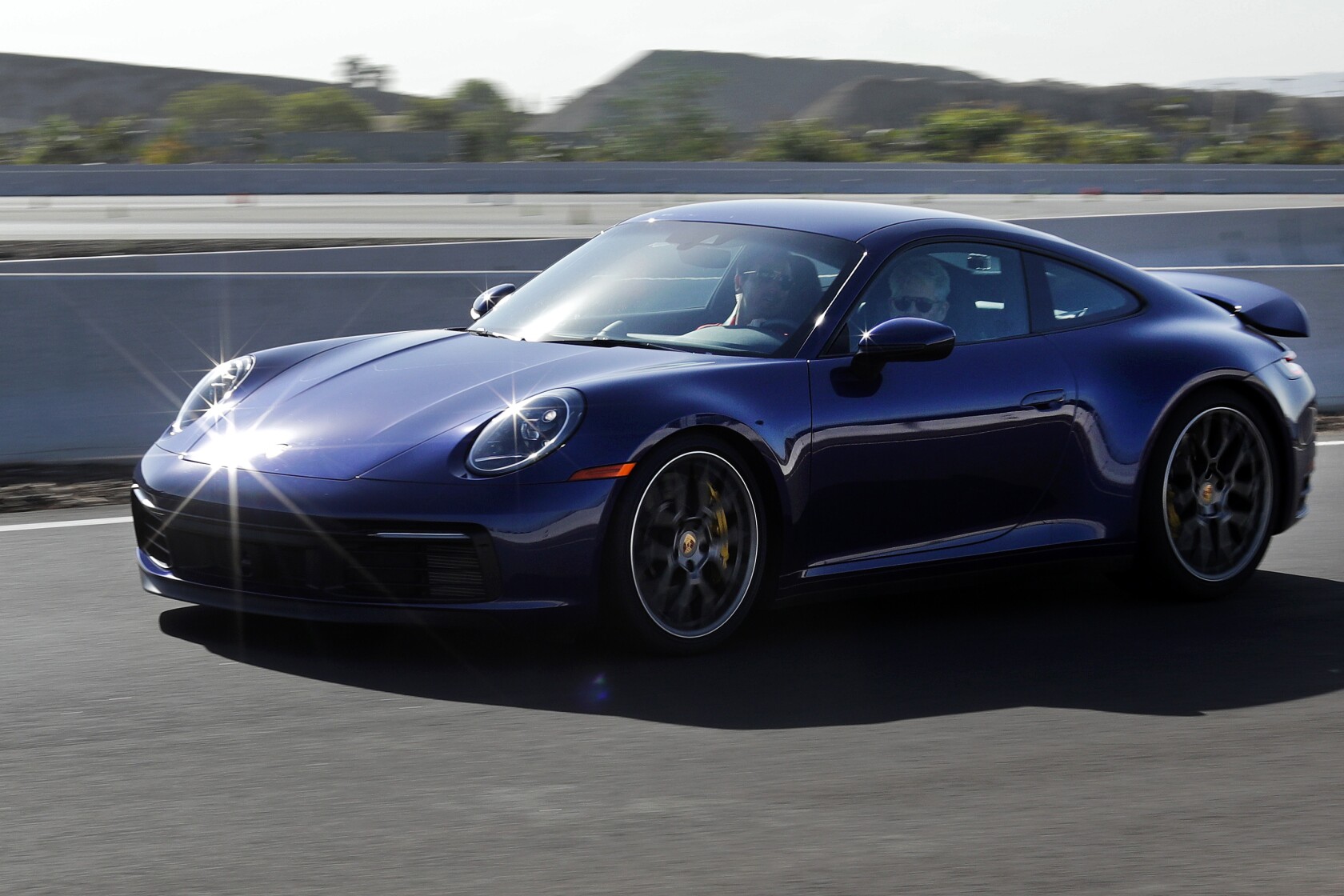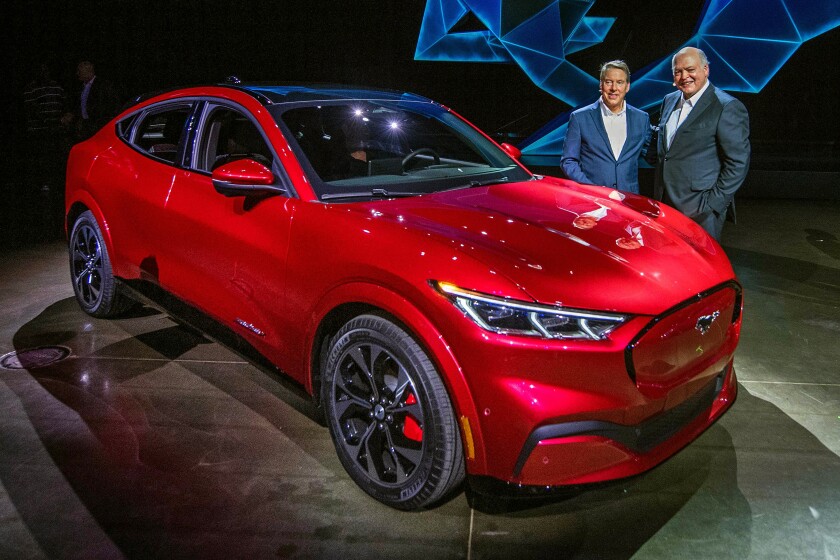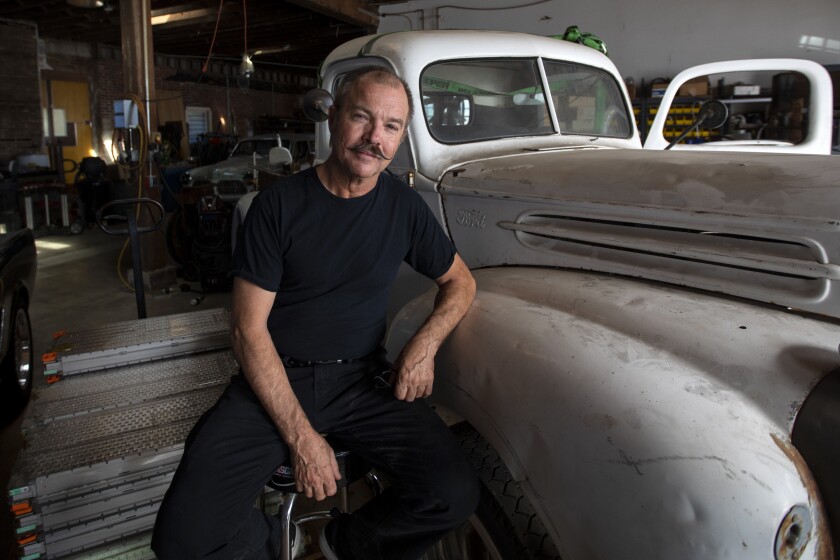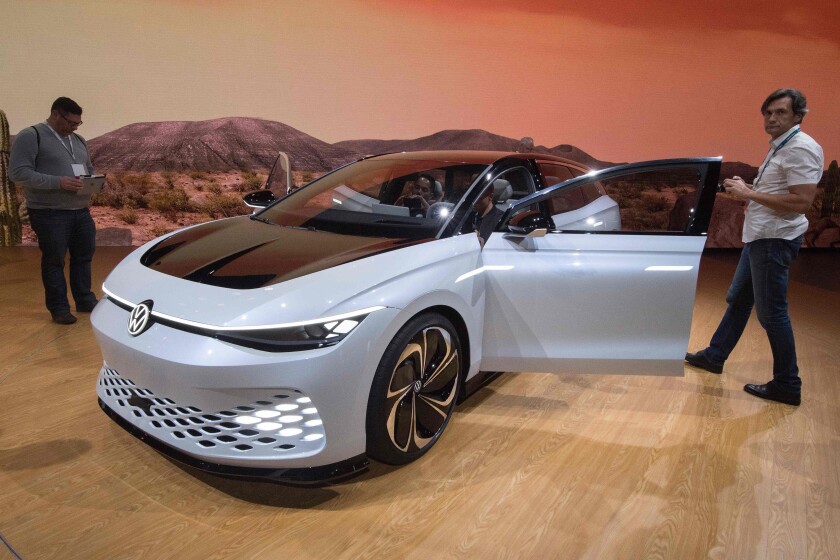
Porsche’s 2020 911 Carrera 4S is so quick and capable that it seemed like only a racetrack could demonstrate its true capabilities.
So, wary of testing the laws of physics and the limits of the California Highway Patrol, I asked the Porsche people if I could have a couple of laps on their Porsche Experience Center track south of downtown Los Angeles. When they said yes, I forgot the Angeles Crest Highway and headed for Carson.
The German car company’s iconic sports car — by no means its bestselling model but still its pride-bound flagship model — is 56 years old and now in its eighth generation. The new iteration differs stylistically only a little. But in terms of performance, as has been the case with every new generation, it’s a new car in impressive new ways.
On the outside, very few alterations from the 2019 911 are visible. The rear of the car is a little wider, almost imperceptibly. It is slightly wider up front, and slightly longer overall — though the wheelbase itself is unchanged. New LED headlights bracket a faintly redesigned hood. Door handles retreat and sit flush within the body, which is now made almost entirely of aluminum. The taillight is now a continuous bar flowing the width of the rear end.
Most non-Porsche people won’t notice these changes. But under the hood, the performance upgrades are dramatic.

The six-cylinder boxer engine, rear-mounted and fitted with twin turbochargers, now puts out 443 horsepower (up 23 ticks from 2019) and 390 pound-feet of torque (up 22 over 2019). It jets from zero to 60 mph in 3.4 seconds, almost half a second faster than its predecessor, and is said to have a top speed of 182 mph.
The improved power is put to the ground via a new eight-speed PDK dual clutch automatic transmission — replacing the earlier seven-speed, and now with the top two gears calibrated for freeway driving — and Porsche’s “active all-wheel-drive” system, which puts the “4” in “4S.” The model I tested also featured the optional rear-axle steering.
Some Porsche admirers are already grousing about the manner in which the new vehicle allows the driver to make manual gear selections. On all Porsches with PDK transmissions, these can be made via paddle shifters mounted to the steering column or by using a “stick shift” on the center console. But Porsche has replaced the console shift knob on previous models with a stubby shift tab. Should size matter? Probably not. But for the purest of purists, Porsche has said it will offer a seven-speed fully manual transmission on the Carrera S and 4S models sometime next year.
Driving modes are Normal, Sport, Sport+ and Wet. Each offers slightly different steering, suspension and transmission settings, and each allows the driver different amounts of available power. (An “Individual” setting allows for customized mode combinations.) Traction control can be removed entirely. The car has a “launch” feature, for drag-race scenarios.
For the first time on a non-GT Porsche, the 2020 911 features “staggered” wheels with 20-inchers up front and 21-inchers in the back. This arrangement, not uncommon on race cars but rare for street machines, is designed to guarantee maximum power to the ground while achieving maximum stability and control.
Porsche’s fantastic PASM suspension system is standard equipment. The PASM Sport Suspension package, previously available only on S and GTS models, is now an option on this car. The 7-inch information touch screen has been increased to 10.9 inches.

New this year is an industry first: The wheels are equipped with rain sensors. If the road is wet (even when the windshield wipers haven’t detected that it’s raining) the driver will get a visual alert on the dashboard suggesting that the car be placed in “wet” driving mode. (This limits power to the wheels and improves traction on slippery surfaces.) How does the car know? There are audio sensors in the wheel well that detect a change in tire noise.
I had a delightful week with the Carrera 4S in its convertible Cabriolet version. Though like all 911s it sits low and requires a certain flexibility for ingress and egress, it drives nicely in traffic, maneuvers beautifully around town, and on longer drives was a pleasant traveling companion.
As a daily driver, it presents challenges. The vehicle rides so close to the ground that, even with the optional electronic nose-lifting feature, I found it difficult to avoid scraping the chin going in and out of driveways.
The back seats? Well, they aren’t really back seats. The storage capacity is minimal. Visibility is only fair. The engine noise, while delightful as engine noise, makes musical enjoyment and telephone conversation somewhat challenging.
I didn’t mind that much, because it sounds so good. How? The press kit offers this baffling explanation: “A sound symposer with a switchable second channel behind the rear trim panel accentuates the classic flat-six sound organically.”
On the other hand, a new deflector, mounted behind the rear seats, significantly reduces wind noise when the top is down.
The combination of power and precision makes this car go fast very quickly. On a canyon road or two, I found I was overly tempted to push the envelope. Wanting to avoid turning the 911 driving experience into a 9-1-1 emergency situation, I contacted Porsche and asked if they’d host me for a spin around their Experience Center.
Opened in 2016, this adrenaline playground offers Porsche enthusiasts a chance to drive perfectly prepared Porsche sports cars on a perfectly maintained race course.
Packages starting as low as $350 — and rising violently higher — put drivers in cars on the track accompanied by driving coaches trained to show them the racing ropes.

That’s what I did, in a hardtop version of the 2020 Carrera 4S. Starting in the passenger seat, for enough laps to show me the course and acquaint me with the best braking points, turn-in spots and apexes, I eventually graduated to the driver’s seat for a few laps at the controls.
A very able coach did his best to help me make the best of the 4S. I did my best to keep the car on the track.
The experience taught me two things.
First, I was able to more fully appreciate the capabilities of this sports car when I had it in a safe, controlled environment that was designed for high-speed performance. The 4S is a remarkable car, and I felt quite comfortable diving into and out of tight corners at speeds I’d never attempt on a public road.
My efforts produced surprisingly little drama. Try as I might, as we switched from Wet to Normal to Sport to Sport+ driving modes, I was not able to pry the wheels from the asphalt, nor push the car so far that it had any difficulty doing as it was asked — though on a final lap, with the traction control eliminated, I broke the back end free a couple of times.
Second, I was able to see what the car could really do when a truly gifted driver was operating it. To paraphrase the Beach Boys, the coach made my Indy 500 look like a Roman chariot race.
Porsche’s 911 sales for 2019 are down from 2018, though the year-to-date sales figure for all models is up 7%. (The top-selling Macan has dropped a bit, but Cayenne sales have almost doubled.)
Will the improvements to the Carrera 4S kick 911 sales up a bit? Probably not much. With MSRPs starting at $121,950 for the hardtop and $134,750 for the convertible, these 911s are not for the faint of heart, or light of wallet.
But the die-hard drivers who applaud any new improvement in the Porsche portfolio will welcome this new 911.
2020 Porsche 911 Carrera 4S Cabriolet
Times’ take: The best keeps getting better
Highs: Quicker, smarter, easier to drive
Lows: Fast and furious speeds are hard to avoid
Vehicle type: Two-door, four-passenger, convertible sports car
Base price: $134,750
Price as tested: $154,470
Powertrain: Three-liter, six-cylinder, twin-turbo gasoline engine
Transmission: Eight-speed automatic, all-wheel drive
Horsepower: 443
Torque: 390 pound-feet
Estimated fuel economy rating: 18 miles per gallon city / 23 highway / 20 combined
[“source=latimes”]